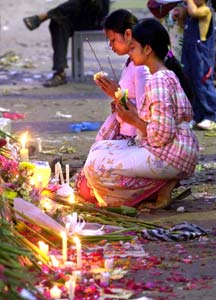|
||||||
|
RELIGION
Outside of India, Bali is the largest Hindu outpost in the world. Put in another way, it's the furthest reaches of the Hindu empire. On Bali Hinduism has developed along lines all its own. In fact, the way in which the Balinese practice their frontier Hinduism is still their greatest art.
Hinduism is at least 3,000 years old and dates from the creation of the Vedas, compilations of prayers, hymns, and other religious writings. Hinduism doesn't have a single founder or prophet. There is only one god, though its many different manifestations are named and classified in great detail.
The Balinese call their religion Agama Tirta ("Science of the Holy Water"), an interpretation of religious ideas from China, India, and Java. Agama Tirta is much closer to the earth and more animist than Hinduism proper; the two sects are as different from each other as Ethiopian Christianity from Episcopalian Christianity.
If a strict Hindu Brahman from Varanasi ever visited Bali, he'd think them savages. Although the Hindu epics are well known and form the basis of favorite Balinese dances, the deities worshipped in India are here considered too aloof and aristocratic. Often the Balinese don't even know their names. |
|
|
The Balinese have their
own trinity of supreme gods, the Shrine of the Three Forces. Because of
the caste system, 200 million people are shunned in India. On Bali only
the older people still believe in the caste system; the young ignore it.
In India a Hindu must be cremated at once in order to enter into heaven;
because of the expense, on Bali sometimes a whole village will
temporarily bury its dead and later stage a mass cremation. In India
widows must not remarry but on Bali they can--here, even high priests
marry. In India,
worship at home is all-important but on Bali group worship is preferred. Gods and goddesses, who protect or threaten every act performed by a person during his or her lifetime, inhabit stone thrones and statues or simply hover in the air. Gods are often invited down to visit earth and are gorged with offerings and entertained with music and dance, but eventually they must go back home because they're too expensive to maintain. The Balinese always try to stay on the good side of all the forces. If the spirits are kept happy, the people can relax and even grow lighthearted. Children carry flowers to shrines and learn to dance at an early age to please the gods and the raja. Feasts mark special
periods in an infant's first year: three days after birth, 42 days after
the first bath, 105 days after birth, and 210 days after birth--the
first birthday celebration. At each stage of the agricultural cycle
ceremonies are held, offerings made, and holy texts chanted. Even
cockfighting was originally a temple ritual--blood spilled for the gods.
During the 1965 political bloodletting in which 50,000 Balinese were
killed, victims dressed in spotless white ceremonial attire before being
led away to execution. Devils were believed to live in the communists or
their sympathizers, and their deaths were necessary to cleanse the
island of evil. Heaven? The Balinese believe heaven will be exactly like
Bali. Get a Balinese
calendar; besides offering faithful pictorial representations of simple,
realistic folk scenes, they show the most propitious days for religious
activities. Try to catch one of the full moon ceremonies, a traditional
affair that can last for some days. Lots of praying, singing, and
dancing--a wonderful opportunity to interact with the people in their
own environment on a special occasion. Your hotel owner will tell you
what to wear or perhaps even dress you in traditional attire.
Incidentally, ceremonies concerning people take place in homes rather
than temples. The temples are only used for ceremonies to gods. The corpse is then carried in a noisy procession to the cremation grounds. On the way it's spun around on top of men's shoulders to confuse the soul and prevent it from finding its way back to its house, where it might make mischief for the living. While tourists trip over themselves taking pictures, the splendid tower, offerings, and coffin are then set ablaze. As matches are considered unclean, blowtorches ignite the pyre, blasting both the cranium and feet, enabling cremations to take place even when it rains. Up until 1903, widows were burned in the great fires of the dead. After the blaze subsides, the eldest son rakes the ashes to make sure all the flesh is burned. To free the soul, the ashes are carried out to sea and scattered. The Balinese don't
sell tickets to their cremations, but they sell transport to the
ceremonies. In tourist resorts you'll see signs announcing the event, as
well as the address and telephone number of the transport agency. The
local tourist office also knows when and where cremations take place.
Some don't need advertising: the 1993 funeral for the last raja of
Gianyar drew 50,000 people, almost two percent of the total Balinese
population. There are temples everywhere--in houses, courtyards, marketplaces, cemeteries, and rice paddies; on beaches, barren rocks offshore, deserted hilltops, and mountain heights; deep inside caves; within the tangled roots of banyan trees. At most intersections and other dangerous places temples are erected to prevent mishaps. Even in the middle of jungle crossroads, incense burns at little shrines. Four sites in particular stand out: Gunung Kawi, Ulun Dau Batur, Ulun Danu Bratan, and Besakih. The last is the Mother Temple of Bali, the state temple. It lies on the slopes of Gunung Agung, the "Navel of the World," the holiest mountain on Bali, where all the gods and goddesses live |
|

